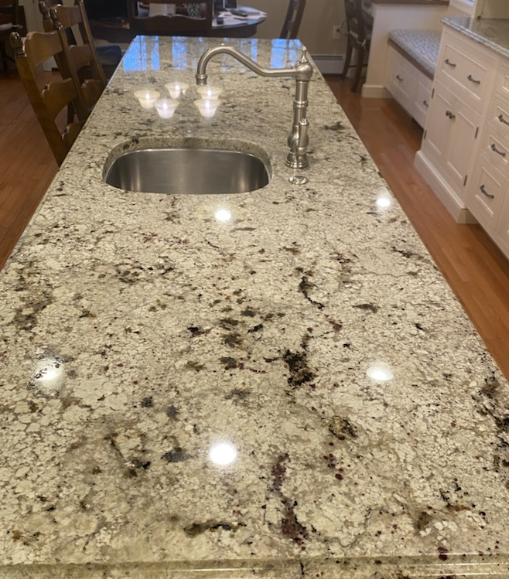Granite
Granite is an igneous rock formed from the crystallization of molten magma beneath the Earth’s surface. It is primarily composed of quartz, feldspar, and mica, which give it a characteristic speckled appearance and make it incredibly durable. Granite is prized for its strength, resistance to scratches, and its beautiful range of colors and patterns. It is commonly used in countertops, flooring, and architectural elements due to its aesthetic appeal and longevity.
Granite Restoration Process
Restoring granite involves several steps to repair and rejuvenate the stone while preserving its natural beauty and strength. Here’s an overview of the typical restoration process:
Assessment and Inspection:
- Evaluation: The granite surface is inspected to identify issues such as scratches, stains, chips, and general wear. This helps in determining the specific restoration needs.
- Testing: Tests may be conducted to understand the type of granite and the extent of damage, guiding the choice of appropriate restoration techniques.
Cleaning:
- Surface Cleaning: The granite is cleaned with a pH-balanced, non-abrasive cleaner to remove dirt, grime, and surface stains. Granite is generally resistant to staining, but regular cleaning helps maintain its appearance.
- Deep Cleaning: For more stubborn stains or accumulated grime, deep cleaning methods such as poultice applications may be used to draw out stains from the stone.
Repair:
- Scratch Removal: Light scratches can be polished out using fine abrasives. For deeper scratches, diamond abrasives or specialized grinding tools are used to smooth the surface.
- Chip Repair: Chips and cracks are filled with a granite repair compound that matches the stone’s color and texture. The repaired areas are then polished to blend seamlessly with the surrounding surface.
Honing and Polishing:
- Honing: If the granite surface is worn or dull, it may be honed using diamond abrasives to remove scratches and imperfections, resulting in a smoother surface.
- Polishing: A polishing compound is applied to restore the granite’s original shine and enhance its natural colors and patterns. This process involves buffing the surface with progressively finer abrasives.
Sealing:
- Application: A high-quality sealer is applied to protect the granite from staining and moisture. Although granite is less porous than other stones, sealing helps maintain its appearance and durability.
- Maintenance: Periodic resealing may be required depending on the usage and environment to ensure ongoing protection.
Final Inspection and Touch-ups:
- Review: A final inspection ensures that all restoration work has been completed to a high standard and that the granite looks as desired.
- Touch-ups: Any minor touch-ups or adjustments are made to achieve a perfect finish.
Why Restore Granite?
- Aesthetic Appeal: Restoration rejuvenates the granite, bringing back its original shine and enhancing its natural beauty.
- Durability: Proper restoration maintains the granite’s structural integrity and extends its lifespan.
- Value: Well-maintained granite can significantly enhance the value and appeal of a property, especially in high-traffic areas like kitchens and bathrooms.
Granite restoration is a meticulous process that requires specialized skills and equipment. By following these steps, professionals can effectively restore granite surfaces, ensuring they continue to look stunning and perform well for many years.


